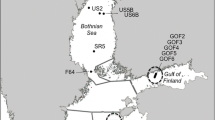Abstract
Physical profile data (salinity, temperature, oxygen, and downwelling irradiance) and in situ incubations of light and dark bottles were used to characterize vertical structure and elucidate mechanisms controlling summertime hypoxia in western Long Island Sound. The period of oxygen depletion corresponded with the period of thermally-controlled stratification. Bulk density differences between surface and bottom waters were only 1.2 to 2.7 sigma-t units; but they were apparently sufficient to resist destratification by winds and tides. Thus oxygen depletion was a cumulative process through the summer. During the stratification period, net oxygen production (measured using light BOD bottles) was confined to a narrow surface zone of 1.8–4.5 m. Below this zone was an intermediate zone of high net oxygen uptake, beneath which was a subpycnoclinic zone where oxygen uptake was very low. Rates of total oxygen uptake (dark bottles) were greatest in the surface layer and diminished with depth. There was close coupling between physical conditions and metabolic structure. Vertical patterns of oxygen production and removal were strongest in calm weather. The location of the intermediate zone corresponded with that of the oxycline. The thickness of the zone and the steepness of the oxycline were determined by the depth and intensity of both physical stratification and biological production and respiration. The biological structure was weakened by physical mixing in the upper water column, and the intermediate zone disappeared with fall destratification. We hypothesize that biological uptake within the water column influences oxygen depletion through two mechanisms. (1) In bottom waters, uptake rates per unit volume are low, but bulk uptake is a significant factor in oxygen depletion because of the large volume of water involved. (2) The intermediate zone, where respiratory uptake is also significant, is strategically located between the surface zone of oxygen renewal and the bottom zone of depletion, where it constitutes an active filter which reinforces the pycnocline as a barrier to vertical oxygen dispersion. The magnitude of direct oxygen removal in the water column relative to removal by sediment oxygen demand and the potential effects of this biological filtering mechanism are important considerations for understanding eutrophication dynamics and managing Long Island Sound. Dynamic models which (1) underestimate the role of water column uptake and (2) incorporate only the two-zone characteristics of physical stratification will tend to (a) overestimate the contribution of sediments to summertime oxygen deficits and (b) overestimate rates of vertical dispersion and reventilation of bottom waters.
Similar content being viewed by others
Literature Cited
Benson B. B. andD. Krause, Jr. 1984. The concentration and isotopic fractionation of oxygen dissolved in freshwater and seawater in equilibrium with the atmosphere.Limnology and Oceanography 23:620–632.
Coffin, R. B. andJ. H. Sharp. 1987. Microbial trophodynamics in the Delaware estuary.Marine Ecology Progress Series 41:253–266.
Ducklow, H. W. 1982. Chesapeake Bay nutrient and plankton dynamics. 1. Bacterial biomass and production during spring tidal destratification in the York River, Virginia, estuary.Limnology and Oceanography 27:651–659.
Goodrich, D. W., W. C. Boicourt, P. Hamilton, andD. W. Pritchard. 1987. Wind-induced destratification in Chesapeake Bay.Journal of Physical Oceanography 17:2232–2240.
Hardy, C. D. 1972. Movement and quality of Long Island Sound waters, 1971. State University of New York. Stony Brook, New York. Technical Report No. 17. 66 p.
Hardy, C. D., andP. K. Weyl. 1971. Distribution of dissolved oxygen in the waters of western Long Island Sound. State University of New York. Stony Brook, New York. Technical Report No. 11. 37 p.
Kemp, W. M. andW. R. Boynton. 1980. Influence of biological and physical processes on dissolved oxygen dynamics in an estuarine system: Implications for measurement of community metabolism.Estuarine and Coastal Marine Science 11: 407–431.
Koppelman, L. E., P. K. Weyl, M. G. Gross, andDew. S. Davies. 1976. The Urban Sea: Long Island Sound. Praeger Publishers, New York. 223 p.
Officer, C. B., R. B. Biggs, J. L. Taft, L. E. Cronin, M. A. Tyler, andW. R. Boynton. 1984. Chesapeake Bay anoxia: Origin, development and significance.Science 223:22–27.
Parker C. A. andJ. E. O’Reilly. 1991. Oxygen depletion in Long Island Sound: A historical perspective.Estuaries 14: 248–264.
Riley, G. A. 1972. Patterns of production in marine ecosystems, p. 91–112.In J. A. Weins (ed.), Ecosystem Structure and Function. Oregon State University Press, Corvallis, Oregon.
Schroeder, W. W. andW. J. Wiseman, Jr. 1988. The Mobile Bay estuary: Stratification, oxygen depletion, and jubilees, p. 41–52.In B. Kjerfve (ed.), Hydrodynamics of Estuaries, Vol. II, Estuarine Case Studies. CRC Press, Boca Raton, Florida.
Strickland, J. D. H. and T. R. Parsons. 1972. A Practical Handbook of Seawater Analysis (2nd ed.). Fisheries Research Board of Canada Bulletin No. 167. 310 p.
Turner, R. E., W. W. Schroeder, andW. J. Wiseman, Jr. 1987. The role of stratification in the deoxygenation of Mobile Bay and adjacent shelf bottom waters.Estuaries 10:13–19.
Webb, K. L. andC. E. D’Elia. 1980. Nutrient and oxygen redistribution during a spring neap tidal cycle in a temperate estuary.Science 207:983–985.
Author information
Authors and Affiliations
Rights and permissions
About this article
Cite this article
Welsh, B.L., Eller, F.C. Mechanisms controlling summertime oxygen depletion in western Long Island Sound. Estuaries 14, 265–278 (1991). https://doi.org/10.2307/1351661
Received:
Accepted:
Issue Date:
DOI: https://doi.org/10.2307/1351661




